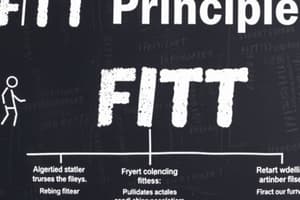Podcast
Questions and Answers
What does FITT stand for?
What does FITT stand for?
Frequency, Intensity, Time, Type
What does Frequency refer to in terms of exercise?
What does Frequency refer to in terms of exercise?
How often you exercise
What is the minimum frequency for moderate intensity exercise to develop cardiorespiratory endurance?
What is the minimum frequency for moderate intensity exercise to develop cardiorespiratory endurance?
Five days a week
What does Intensity refer to in exercise?
What does Intensity refer to in exercise?
Which of the following are categories of intensity? (Select all that apply)
Which of the following are categories of intensity? (Select all that apply)
What is an example of light or leisure-time intensity activity?
What is an example of light or leisure-time intensity activity?
What is considered moderate intensity exercise?
What is considered moderate intensity exercise?
What is an example of vigorous intensity exercise?
What is an example of vigorous intensity exercise?
What is the Heart Rate Reserve Method used for?
What is the Heart Rate Reserve Method used for?
Flashcards are hidden until you start studying
Study Notes
FITT Principle
- FITT stands for Frequency, Intensity, Time, and Type, a framework for exercise prescription.
Frequency
- Frequency indicates how often exercise is performed.
- Recommended frequency varies:
- Cardiorespiratory endurance: at least five days for moderate intensity, three days for vigorous.
- Muscular strength: two to three days per week targeting major muscle groups.
- Regular exercise is essential for effectiveness.
Intensity
- Intensity reflects the effort level during exercise.
- Muscles, including the heart, require overload (working beyond normal capacity) to gain strength.
- Sustained exercise must exceed normal levels for improved muscular endurance.
- Insufficient overload can lead to reduced fitness levels.
Categories of Intensity
- Exercises fall into three intensity categories:
- Light or Leisure time
- Moderate
- Vigorous
Light or Leisure Time Intensity
- Light activities do not provide significant health benefits.
- Examples include slow walking, gardening, and light stretching.
Moderate Intensity
- A noticeable increase in breathing and heart rate characterizes moderate intensity (RPE scale: 4-5, METs: 3-6).
- Provides health benefits associated with exercise.
- Examples: brisk walking, golf (carrying clubs), recreational swimming, doubles tennis, and light weightlifting.
Vigorous Intensity
- Vigorous intensity presents a significant challenge (RPE scale: 5 or greater, METs: over 6).
- Leads to a substantial increase in breathing and heart rate.
- Examples: race-walking, jogging, swimming laps, mowing the lawn with a hand mower, singles tennis, and fast biking.
Measuring Intensity: Heart Rate Reserve Method
- The Heart Rate Reserve method connects heart rate with exercise intensity.
- Heart rate increases linearly with exercise intensity until maximum heart rate is reached, which is the upper limit during maximal exertion.
- To find the target heart rate zone for improving cardiorespiratory endurance:
- Measure resting heart rate first thing in the morning.
- Resting heart rate can be taken at the carotid or radial artery.
- Avoid using the thumb to measure heart rate due to its own pulse.
Studying That Suits You
Use AI to generate personalized quizzes and flashcards to suit your learning preferences.




